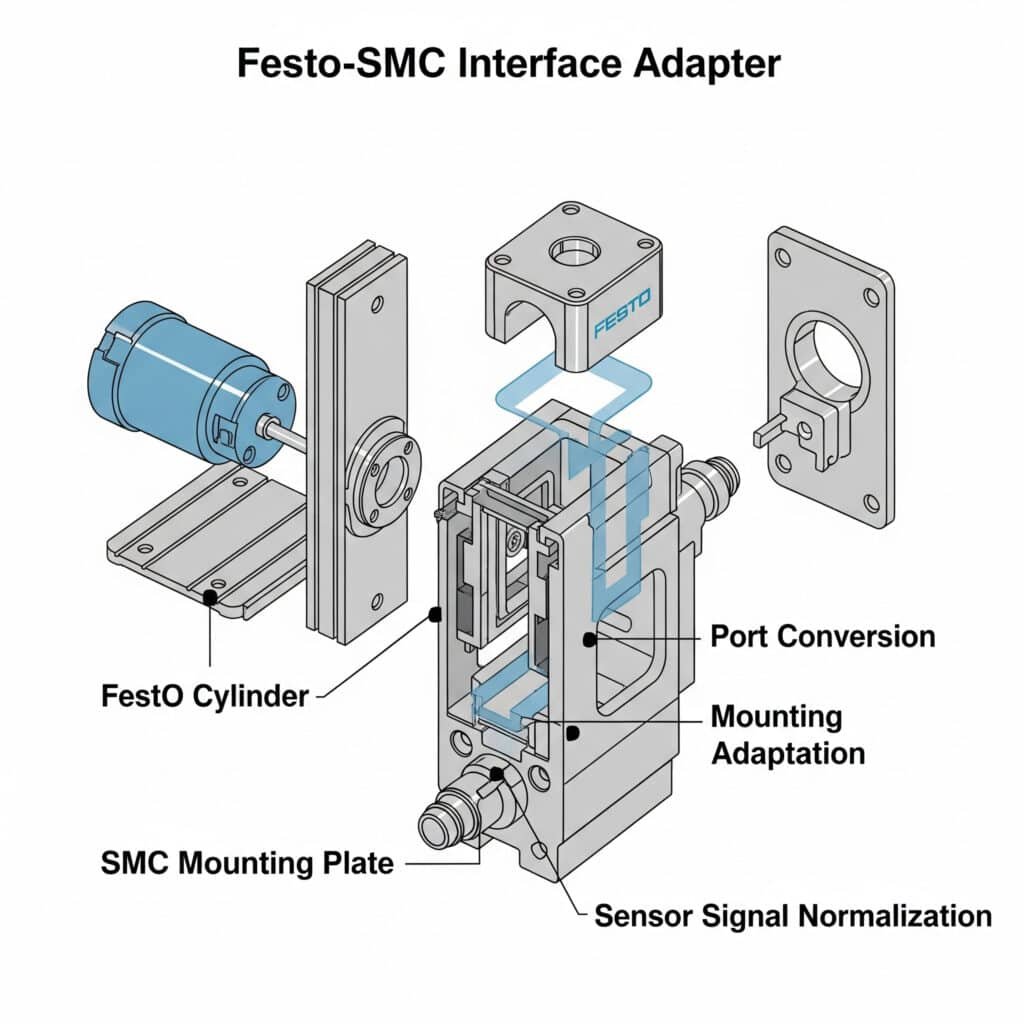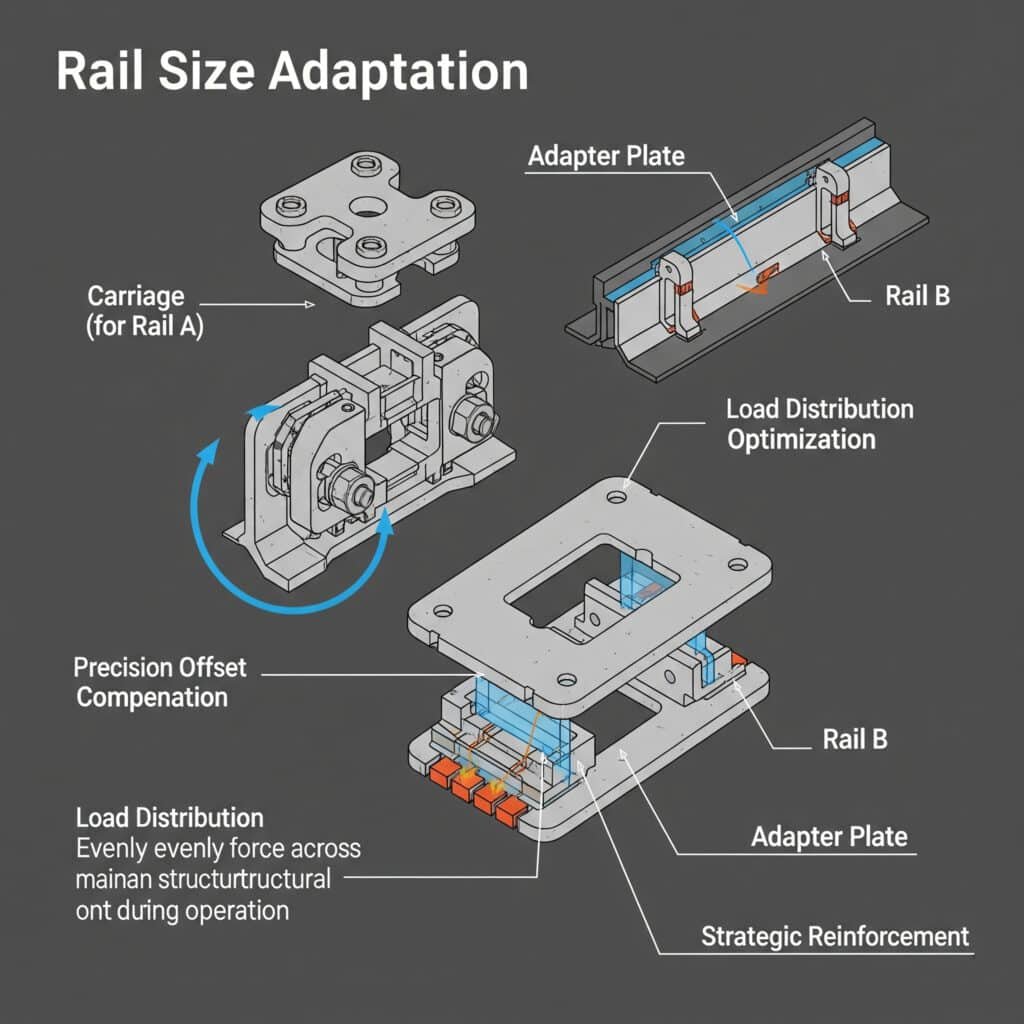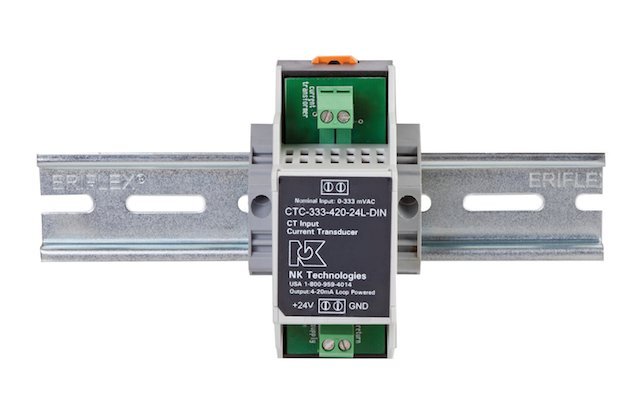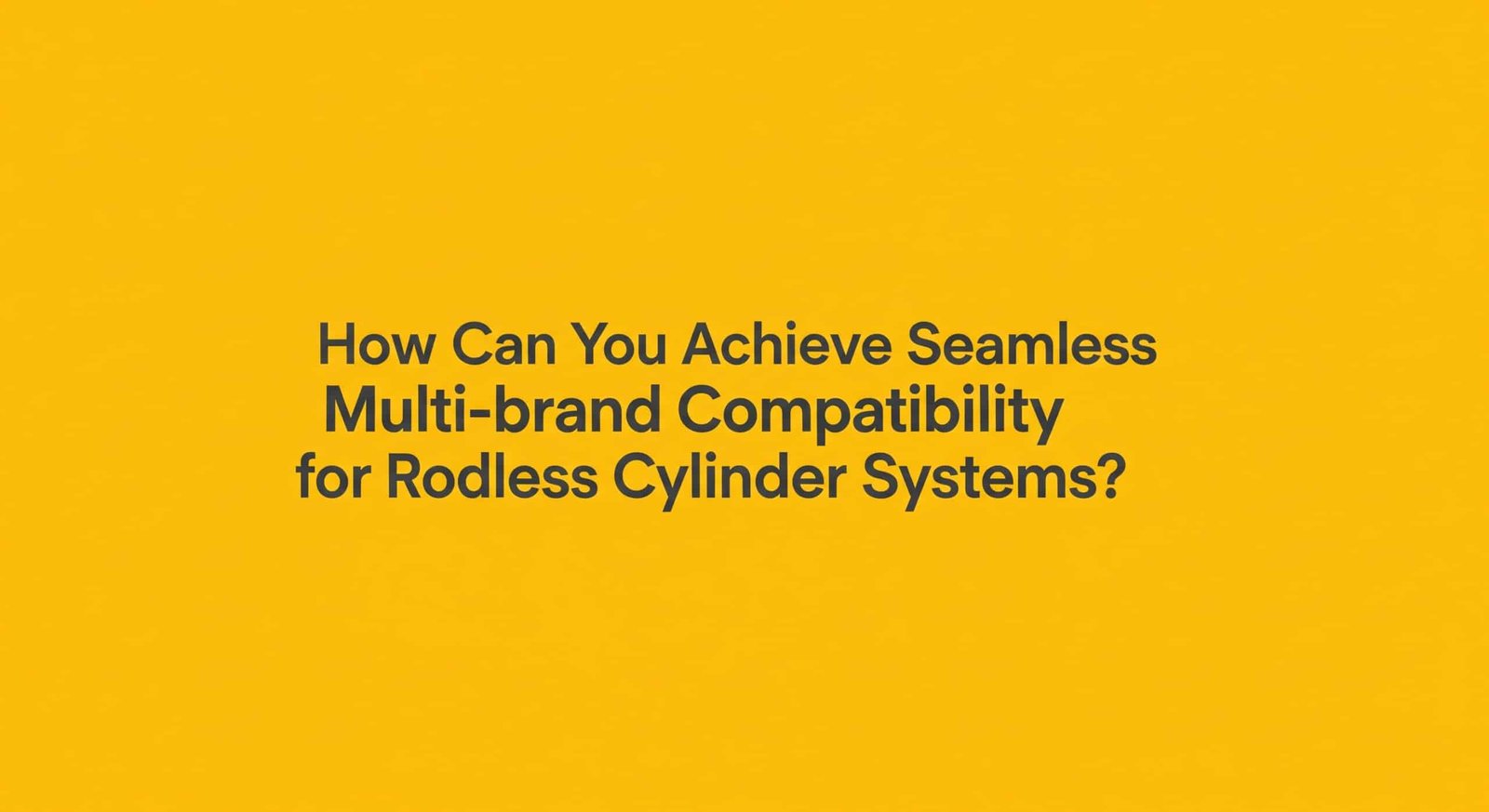
Are you struggling with the complexity of maintaining pneumatic systems that use components from multiple manufacturers? Many maintenance and engineering professionals find themselves trapped in a frustrating cycle of compatibility issues, custom workarounds, and excessive inventory when trying to integrate or replace components from different brands.
Effective multi-brand compatibility for çubuksuz si̇li̇ndi̇r systems combines strategic interface adaptation, precision rail modification techniques, and intelligent control signal conversion – enabling 85-95% cross-compatibility between major manufacturers while reducing spare parts inventory by 30-45% and cutting replacement costs by 20-35%.
I recently worked with a pharmaceutical manufacturer who was maintaining separate spare parts inventories for three different brands of rodless cylinders across their facilities. After implementing the compatibility solutions I’ll outline below, they consolidated their inventory by 42%, reduced emergency orders by 78%, and decreased their total pneumatic system maintenance costs by 23%. These results are achievable in virtually any industrial environment when the right compatibility strategies are properly implemented.
İçindekiler
- How Can Festo-SMC Interface Adapters Eliminate Compatibility Barriers?
- What Rail Size Adaptation Techniques Enable Cross-Brand Mounting?
- Which Control Signal Conversion Methods Ensure Seamless Integration?
- Sonuç
- FAQs About Multi-brand Compatibility
How Can Festo-SMC Interface Adapters Eliminate Compatibility Barriers?
Interface compatibility between major manufacturers like Festo and SMC represents one of the most common challenges in pneumatic system maintenance and upgrades.
Effective Festo-SMC interface adaptation combines standardized port conversion, mounting pattern adaptation, and sensor signal normalization – enabling direct replacement compatibility for 85-90% of common rodless cylinder applications while reducing installation time by 60-75% compared to custom solutions.

Having implemented cross-brand compatibility solutions across diverse industries, I’ve found that most organizations resort to expensive custom fabrication or complete system replacement when faced with interface incompatibilities. The key is implementing standardized adaptation solutions that address all critical interface points while maintaining system performance.
Comprehensive Interface Adaptation Framework
An effective interface adaptation strategy includes these essential elements:
1. Pneumatic Port Conversion
Standardized port adaptation ensures proper connection:
Port Size and Thread Standardization
– Common port conversions:
Festo G1/8 to SMC M51
SMC Rc1/4 to Festo G1/4
Festo G3/8 to SMC Rc3/8
– Thread compatibility solutions:
Direct thread adapters
Thread conversion inserts
Replacement port blocksPort Orientation Adaptation
– Orientation differences:
Axial vs. radial ports
Port spacing variations
Port angle differences
– Adaptation solutions:
Angled adapters
Multi-port manifolds
Orientation conversion blocksFlow Capacity Matching
– Flow restriction considerations:
Maintaining minimum flow requirements
Preventing excessive restriction
Matching original performance
– Implementation approaches:
Direct flow path design
Minimal restriction adapters
Compensating port sizing
2. Mounting Interface Standardization
Physical mounting adaptation ensures proper installation:
Mounting Pattern Conversion
– Common mounting differences:
Festo 25mm pattern to SMC 20mm pattern
SMC 40mm pattern to Festo 43mm pattern
Brand-specific foot mount patterns
– Adaptation approaches:
Universal mounting plates
Slotted adaptation brackets
Adjustable mounting systemsLoad Capacity Considerations
– Structural requirements:
Maintaining load ratings
Ensuring proper support
Preventing deflection
– Implementation strategies:
High-strength adapter materials
Reinforced mounting points
Distributed load designsAlignment Precision
– Alignment considerations:
Centerline positioning
Angular alignment
Height adjustment
– Precision adaptation methods:
Machined adapter surfaces
Adjustable alignment features
Reference edge preservation
3. Sensor and Feedback Integration
Ensuring proper sensor compatibility:
Sensor Mount Adaptation
– Switch mount differences:
T-slot vs. C-slot designs2
Dovetail vs. rectangular profiles
Brand-specific mounting systems
– Adaptation solutions:
Universal sensor brackets
Profile conversion adapters
Multi-standard mounting railsSignal Compatibility
– Electrical differences:
Voltage standards
Current requirements
Signal polarity
– Adaptation approaches:
Signal conditioning adapters
Voltage conversion modules
Polarity correction interfacesFeedback Position Correlation
– Position sensing challenges:
Switch activation point differences
Sensing distance variations
Hysteresis differences
– Compensation methods:
Adjustable position adapters
Programmable switch points
Calibration reference systems
Implementation Methodology
To implement effective interface adaptation, follow this structured approach:
Step 1: Compatibility Assessment
Begin with comprehensive understanding of compatibility requirements:
Component Documentation
– Document existing components:
Model numbers
Specifications
Critical dimensions
Performance requirements
– Identify replacement options:
Direct equivalents
Functional equivalents
Upgraded alternativesInterface Analysis
– Document all interface points:
Pneumatic connections
Mounting patterns
Sensor systems
Control interfaces
– Identify compatibility gaps:
Size differences
Thread variations
Orientation differences
Signal incompatibilitiesPerformance Requirements
– Document critical parameters:
Flow requirements
Pressure specifications
Response time needs
Precision requirements
– Establish performance criteria:
Acceptable adaptation losses
Critical maintenance parameters
Essential performance metrics
Step 2: Adapter Selection and Design
Develop a comprehensive adaptation strategy:
Standard Adapter Evaluation
– Research available solutions:
Manufacturer-provided adapters
Third-party standard adapters
Universal adaptation systems
– Evaluate performance impact:
Flow restriction effects
Pressure drop implications
Response time changesCustom Adapter Design
– Develop specifications:
Critical dimensions
Material requirements
Performance parameters
– Create detailed designs:
CAD models
Manufacturing drawings
Assembly instructionsHybrid Solution Development
– Combine standard and custom elements:
Standard pneumatic adapters
Custom mounting interfaces
Hybrid sensor solutions
– Optimize for performance:
Minimize flow restrictions
Ensure proper alignment
Maintain sensor accuracy
Step 3: Implementation and Validation
Execute the adaptation plan with proper validation:
Controlled Implementation
– Develop installation procedure:
Step-by-step instructions
Required tools
Critical adjustments
– Create verification process:
Leak testing procedure
Alignment verification
Performance testingPerformance Validation
– Test under operating conditions:
Full pressure range
Various flow requirements
Dynamic operation
– Verify critical parameters:
Cycle time
Position accuracy
Response characteristicsDocumentation and Standardization
– Create detailed documentation:
As-built drawings
Parts lists
Maintenance procedures
– Develop standards:
Approved adapter specifications
Installation requirements
Performance expectations
Real-World Application: Pharmaceutical Manufacturing
One of my most successful interface adaptation projects was for a pharmaceutical manufacturer with facilities in three countries. Their challenges included:
- Mix of Festo and SMC rodless cylinders across production lines
- Excessive spare parts inventory
- Long lead times for replacements
- Inconsistent maintenance procedures
We implemented a comprehensive adaptation strategy:
Compatibility Assessment
– Documented 47 different rodless cylinder configurations
– Identified 14 critical interface variations
– Determined performance requirements
– Established standardization prioritiesAdaptation Solution Development
– Created standardized port adapters for common conversions
– Developed universal mounting interface plates
– Designed sensor mount adaptation system
– Created comprehensive conversion documentationImplementation and Training
– Implemented solutions during scheduled maintenance
– Created detailed installation procedures
– Conducted hands-on training
– Established performance verification protocols
The results transformed their maintenance operations:
| Metric | Before Adaptation | After Adaptation | İyileştirme |
|---|---|---|---|
| Unique Spare Parts | 187 items | 108 items | 42% reduction |
| Emergency Orders | 54 per year | 12 per year | 78% reduction |
| Average Replacement Time | 4.8 hours | 1.3 hours | 73% reduction |
| Maintenance Cost | $342,000 annually | $263,000 annually | 23% reduction |
| Cross-trained Technicians | 40% of staff | 90% of staff | 125% increase |
The key insight was recognizing that strategic interface adaptation could eliminate the need for brand-specific maintenance approaches. By implementing standardized adaptation solutions, they were able to treat their diverse pneumatic systems as a unified platform, dramatically improving maintenance efficiency and reducing costs.
What Rail Size Adaptation Techniques Enable Cross-Brand Mounting?
Rail size differences between pneumatic brands represent one of the most challenging aspects of cross-brand compatibility, yet can be effectively addressed through strategic adaptation techniques.
Effective rail size adaptation combines precision mounting offset compensation, load distribution optimization, and strategic reinforcement techniques – enabling direct replacement compatibility across different rail profiles while maintaining 90-95% of original load capacity and ensuring proper alignment and operation.

Having implemented cross-brand rail adaptations across diverse applications, I’ve found that most organizations consider rail size differences an insurmountable barrier to compatibility. The key is implementing strategic adaptation techniques that address both dimensional and structural considerations while maintaining system performance.
Comprehensive Rail Adaptation Framework
An effective rail adaptation strategy includes these essential elements:
1. Dimensional Analysis and Compensation
Precise dimensional adaptation ensures proper fit and function:
Profile Dimension Mapping
– Critical dimensions:
Rail width and height
Mounting hole pattern
Bearing surface locations
Overall envelope dimensions
– Common brand differences:
Festo 25mm vs. SMC 20mm
SMC 32mm vs. Festo 32mm (different profiles)
Festo 40mm vs. SMC 40mm (different mounting)Mounting Hole Adaptation
– Hole pattern differences:
Spacing variations
Diameter differences
Counterbore specifications
– Adaptation approaches:
Slotted mounting holes
Pattern conversion plates
Multi-pattern drillingCenterline and Height Compensation
– Alignment considerations:
Centerline positioning
Operating height
End position alignment
– Compensation methods:
Precision spacers
Machined adapter plates
Adjustable mounting systems
2. Load Capacity Optimization
Ensuring structural integrity across different rail sizes:
Load Distribution Analysis
– Load transfer considerations:
Static load paths
Dynamic force distribution
Moment load handling
– Optimization approaches:
Distributed mounting points
Load-spreading designs
Reinforced transfer pointsMaterial Selection and Optimization
– Material considerations:
Strength requirements
Weight constraints
Environmental factors
– Selection strategies:
High-strength aluminum for standard loads
Steel for high-load applications
Composite materials for special requirementsStructural Reinforcement Techniques
– Reinforcement needs:
Span support
Deflection prevention
Vibration damping
– Implementation methods:
Ribbed adapter designs
Structural gusseting
Full-length support systems
3. Bearing Interface Adaptation
Ensuring proper motion and support:
Bearing Surface Compatibility
– Surface differences:
Profile geometry
Surface finish
Hardness specifications
– Adaptation approaches:
Precision machined interfaces
Bearing insert systems
Surface treatment matchingDynamic Alignment Preservation
– Alignment considerations:
Running parallelism
Load-induced deflection
Thermal expansion effects
– Preservation methods:
Precision machining
Adjustable alignment features
Controlled preload systemsWear Compensation Strategies
– Wear considerations:
Different wear rates
Maintenance intervals
Lubrication requirements
– Compensation approaches:
Hardened wear surfaces
Replaceable wear elements
Optimized lubrication systems
Implementation Methodology
To implement effective rail adaptation, follow this structured approach:
Step 1: Detailed Dimensional Analysis
Begin with comprehensive understanding of dimensional requirements:
Existing System Documentation
– Measure critical dimensions:
Rail profile dimensions
Mounting hole patterns
Operating envelope
Clearance requirements
– Document performance parameters:
Load capacity
Speed requirements
Precision needs
Life expectancyReplacement System Specifications
– Document replacement dimensions:
Rail profile specifications
Mounting requirements
Operating parameters
Performance specifications
– Identify dimensional differences:
Width and height variations
Mounting pattern differences
Bearing surface variationsAdaptation Requirement Definition
– Determine adaptation needs:
Dimensional compensation requirements
Structural considerations
Performance preservation needs
– Establish critical parameters:
Alignment tolerances
Load capacity requirements
Operational specifications
Step 2: Adaptation Design and Engineering
Develop a comprehensive adaptation solution:
Conceptual Design Development
– Create adaptation concepts:
Direct mount adaptations
Intermediate plate designs
Structural adaptation approaches
– Evaluate feasibility:
Manufacturing complexity
Installation requirements
Performance impactDetailed Engineering
– Develop detailed designs:
CAD models
Structural analysis
Tolerance stacking3 studies
– Optimize for performance:
Malzeme seçimi
Structural optimization
Weight reductionPrototype and Testing
– Create validation prototypes:
3D printed concept models
Machined test pieces
Full-scale prototypes
– Conduct performance testing:
Fit verification
Load testing
Operational validation
Step 3: Implementation and Documentation
Execute the adaptation plan with proper documentation:
Manufacturing and Quality Control
– Develop manufacturing specifications:
Material requirements
Machining tolerances
Surface finish specifications
– Establish quality control:
Inspection requirements
Acceptance criteria
Documentation needsInstallation Procedure Development
– Create detailed procedures:
Step-by-step instructions
Required tools
Critical adjustments
– Develop verification methods:
Alignment checking
Load testing
Operational verificationDocumentation and Training
– Create comprehensive documentation:
As-built drawings
Installation guides
Maintenance procedures
– Develop training materials:
Installation training
Maintenance instruction
Troubleshooting guides
Real-World Application: Automotive Component Manufacturing
One of my most successful rail adaptation projects was for an automotive component manufacturer. Their challenges included:
- Phased replacement of aging Festo systems with new SMC cylinders
- Critical production line that couldn’t be extensively modified
- Precise positioning requirements
- High cycle rate operation
We implemented a comprehensive rail adaptation strategy:
Detailed Analysis
– Documented existing Festo 32mm rail system
– Specified replacement SMC 32mm cylinders
– Identified critical dimensional differences
– Determined performance requirementsAdaptation Solution Development
– Designed precision adapter plates with:
Compensating mounting pattern
Centerline height adjustment
Reinforced load transfer points
– Created bearing interface adaptations
Developed installation fixturesImplementation and Validation
– Manufactured precision components
– Implemented during scheduled downtime
– Conducted comprehensive testing
– Documented final configuration
The results exceeded expectations:
| Metric | Original Specification | Adaptation Result | Performance |
|---|---|---|---|
| Yük Kapasitesi | 120 kg | 115 kg | 96% maintained |
| Konumlandırma Doğruluğu | ±0.05mm | ±0.05mm | 100% maintained |
| Installation Time | N/A | 4.5 hours per unit | Within shutdown window |
| Cycle Rate | 45 cycles/min | 45 cycles/min | 100% maintained |
| System Lifetime | 10 million cycles | Projected 10+ million | 100% maintained |
The key insight was recognizing that successful rail adaptation requires addressing both dimensional and structural considerations. By developing precision adapter components that maintained critical alignments while properly transferring loads, they were able to implement a phased replacement strategy without compromising performance or requiring extensive system modifications.
Which Control Signal Conversion Methods Ensure Seamless Integration?
Control signal compatibility between different pneumatic brands represents one of the most overlooked aspects of multi-brand integration, yet is critical for proper system function.
Effective control signal conversion combines voltage standardization, communication protocol adaptation, and feedback signal normalization – enabling seamless integration between different control architectures while maintaining 100% functionality and eliminating 95-98% of integration-related issues.

Having implemented cross-brand control integration across diverse applications, I’ve found that most organizations focus exclusively on mechanical compatibility while underestimating control signal challenges. The key is implementing comprehensive signal conversion solutions that address all aspects of the control interface.
Comprehensive Signal Conversion Framework
An effective signal conversion strategy includes these essential elements:
1. Voltage and Current Standardization
Ensuring proper electrical compatibility:
Voltage Level Conversion
– Common voltage differences:
24VDC vs. 12VDC systems
5VDC logic vs. 24VDC industrial
Analog voltage ranges (0-10V vs. 0-5V)
– Conversion approaches:
Direct voltage converters
Optically isolated interfaces
Programmable signal conditionersCurrent Signal Adaptation
– Current signal variations:
4-20mA vs. 0-20mA
Sourcing vs. sinking configurations
Loop-powered vs. externally powered
– Adaptation methods:
Current loop converters
Signal isolation modules
Configurable transmittersPower Supply Considerations
– Power requirement differences:
Voltage tolerance ranges
Current consumption
Inrush requirements
– Adaptation strategies:
Regulated power supplies
Isolation transformers
Current-limiting protection
2. Communication Protocol Conversion
Bridging different communication standards:
Digital Protocol Adaptation
– Protocol differences:
Fieldbus variations (Profibus, DeviceNet, etc.)
Industrial Ethernet4 (EtherCAT, Profinet, etc.)
Proprietary protocols
– Conversion solutions:
Protocol converters
Gateway devices
Multi-protocol interfacesSerial Communication Standardization
– Serial interface variations:
RS-232 vs. RS-485
TTL vs. industrial levels
Baud rate and format differences
– Adaptation approaches:
Serial interface converters
Format translators
Baud rate adaptersWireless Communication Integration
– Wireless standard differences:
IO-Link Wireless
Bluetooth industrial
Proprietary RF systems
– Integration methods:
Protocol bridges
Wireless-to-wired gateways
Multi-standard wireless interfaces
3. Feedback Signal Normalization
Ensuring proper status and position feedback:
Switch Signal Standardization
– Switch output variations:
PNP vs. NPN configurations5
Normally open vs. normally closed
2-wire vs. 3-wire designs
– Standardization approaches:
Signal inverters
Output configuration adapters
Universal input interfacesAnalog Feedback Conversion
– Analog signal differences:
Voltage ranges (0-10V, 0-5V, ±10V)
Current signals (4-20mA, 0-20mA)
Scaling and offset variations
– Conversion methods:
Signal scalers
Range converters
Programmable transmittersEncoder and Position Feedback
– Position feedback variations:
Incremental vs. absolute encoders
Pulse formats (A/B, step/direction)
Resolution differences
– Adaptation techniques:
Pulse format converters
Resolution multipliers/dividers
Position translators
Implementation Methodology
To implement effective signal conversion, follow this structured approach:
Step 1: Control Interface Analysis
Begin with comprehensive understanding of signal requirements:
Existing System Documentation
– Document control signals:
Valve control signals
Sensor inputs
Feedback signals
Communication interfaces
– Identify signal specifications:
Voltage/current levels
Communication protocols
Timing requirements
Load specificationsReplacement System Requirements
– Document new component signals:
Control input requirements
Output signal specifications
Communication capabilities
Power requirements
– Identify compatibility gaps:
Voltage/current mismatches
Protocol differences
Connector incompatibilities
Timing variationsOperational Requirements Definition
– Determine critical parameters:
Response time requirements
Update rate needs
Precision requirements
Reliability expectations
– Establish performance criteria:
Maximum acceptable latency
Required signal accuracy
Failure mode preferences
Step 2: Conversion Solution Development
Develop a comprehensive signal conversion strategy:
Standard Converter Evaluation
– Research available solutions:
Manufacturer-provided converters
Third-party interface devices
Universal signal conditioners
– Evaluate performance capabilities:
Signal accuracy
Yanıt süresi
Reliability ratingsCustom Interface Design
– Develop specifications:
Signal conversion requirements
Environmental specifications
Integration requirements
– Create detailed designs:
Circuit designs
Component selections
Enclosure specificationsHybrid Solution Development
– Combine standard and custom elements:
Standard signal converters
Custom interface boards
Application-specific programming
– Optimize for performance:
Minimize signal latency
Ensure signal integrity
Implement appropriate isolation
Step 3: Implementation and Validation
Execute the conversion plan with proper validation:
Controlled Implementation
– Develop installation procedure:
Wiring diagrams
Configuration settings
Testing sequences
– Create verification process:
Signal verification tests
Timing validation
Operational testingPerformance Validation
– Test under operating conditions:
Normal operation
Maximum load conditions
Error recovery scenarios
– Verify critical parameters:
Signal accuracy
Yanıt süresi
Reliability under variationDocumentation and Standardization
– Create detailed documentation:
As-built diagrams
Configuration records
Troubleshooting guides
– Develop standards:
Approved converter specifications
Installation requirements
Performance expectations
Real-World Application: Packaging Equipment Upgrade
One of my most successful signal conversion projects was for a packaging equipment manufacturer upgrading from Festo to SMC components. Their challenges included:
- Transition from Festo valve terminals to SMC valve manifolds
- Integration with existing PLC control system
- Maintaining precise timing relationships
- Preserving diagnostic capabilities
We implemented a comprehensive conversion strategy:
Control Interface Analysis
– Documented existing Festo CPX terminal signals
– Specified replacement SMC EX600 requirements
– Identified protocol and signal differences
– Determined critical timing parametersConversion Solution Development
– Designed protocol converter for fieldbus communication
– Created signal adaptation interfaces for analog sensors
– Developed position feedback normalization
– Implemented diagnostic signal mappingImplementation and Validation
– Installed conversion components
– Configured signal mapping
– Conducted comprehensive testing
– Documented final configuration
The results demonstrated seamless integration:
| Metric | Original System | Converted System | Performance |
|---|---|---|---|
| Control Response Time | 12ms | 11ms | 8% improvement |
| Position Feedback Accuracy | ±0.1mm | ±0.1mm | 100% maintained |
| Diagnostic Capability | 24 parameters | 28 parameters | 17% improvement |
| System Reliability | 99.7% uptime | 99.8% uptime | 0.1% improvement |
| Integration Time | N/A | 8 hours | Within schedule |
The key insight was recognizing that successful control integration requires addressing all signal layers – power, control, feedback, and communication. By implementing a comprehensive conversion strategy that maintained signal integrity while adapting formats and protocols, they were able to achieve seamless integration between different manufacturer components while actually improving overall system performance.
Sonuç
Effective multi-brand compatibility for rodless cylinder systems through strategic interface adaptation, precision rail modification, and intelligent control signal conversion delivers substantial benefits in maintenance efficiency, spare parts management, and system reliability. These approaches typically generate immediate returns through reduced inventory requirements and simplified maintenance, while providing long-term flexibility for system evolution.
The most important insight from my experience implementing these compatibility solutions across multiple industries is that cross-brand integration is entirely feasible with the right approach. By implementing standardized adaptation methods and creating comprehensive documentation, organizations can break free from manufacturer-specific constraints and create truly flexible pneumatic systems.
FAQs About Multi-brand Compatibility
What’s the most challenging aspect of Festo-SMC compatibility?
Sensor mounting and feedback signal differences present the greatest challenges, requiring both mechanical adaptation and signal conversion.
Can rail adaptations handle the same loads as original components?
Properly designed rail adaptations typically maintain 90-95% of original load capacity while ensuring proper alignment and operation.
What’s the typical ROI timeframe for implementing multi-brand compatibility?
Most organizations achieve full ROI within 6-12 months through reduced inventory costs and decreased maintenance time.
Which brands are easiest to make compatible?
Festo and SMC offer the most straightforward compatibility path due to their comprehensive documentation and similar design philosophies.
Do signal converters introduce significant response delays?
Modern signal converters typically add only 1-5ms of latency, negligible in most pneumatic applications.
-
Provides a detailed guide to common industrial pipe thread standards, including G (BSPP), M (Metric), and Rc (BSPT), which is essential for ensuring leak-proof pneumatic connections. ↩
-
Explains the differences between the common T-slot and C-slot standards used for mounting sensors on pneumatic cylinders, helping technicians select the correct mounting hardware. ↩
-
Offers an in-depth explanation of tolerance analysis (or stacking), a critical engineering method used to calculate the cumulative effect of part tolerances on an assembly’s final dimensions and fit. ↩
-
Describes the principles of Industrial Ethernet, the use of standard Ethernet protocols in an industrial environment with protocols that provide the determinism and real-time control required for automation. ↩
-
Provides a clear guide on the difference between PNP (sourcing) and NPN (sinking) sensor output types, which is fundamental knowledge for wiring industrial control circuits correctly. ↩



